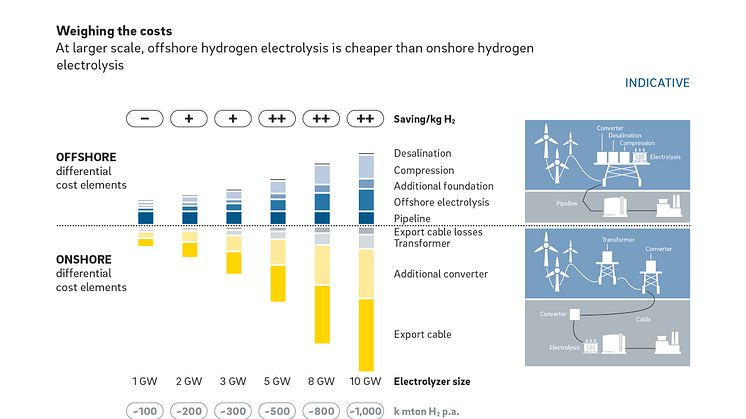
Press release -
Offshore wind sector can increase economic potential through green hydrogen conversion and floating technology
- Green hydrogen is one of the cornerstones of the energy transition
- Floating technology can harness wind along deeper coastal waters and increase the scope for low-cost hydrogen production
- Further cost cutting is necessary if the European offshore wind energy sector is to stay competitiv
Munich, June 2021: The last decade saw a remarkable rise in offshore wind energy (OWE). This once expensive and immature technology is now cost-competitive with electricity from fossil sources and will only become more so as CO2 prices increase. In fact, many countries now see it as a key pillar of their decarbonization strategies to meet climate targets and therefore great capacity expansions are planned. For example, the European Union intends to develop 300 GW of OWE by 2050. In its focus study, “Innovate and industrialize – How Europe's offshore wind sector can maintain market leadership and meet the continent's energy goals”, Roland Berger discusses how the sector can increase its economic potential through hydrogen conversion, use of floating wind parks and cost reduction.
“Offshore wind is becoming an ever more important route to tackling climate change,” says Torsten Henzelmann, Partner at Roland Berger. “It already provides a competitive, clean alternative to fossil electricity and using it to produce green hydrogen at the source will take it to the next level. We are excited by the opportunities it offers Europe to achieve its climate goals, consolidate its market leadership and capture the downstream value added of hydrogen when it is used as a feedstock, such as in the production of synthetic fuels or green chemicals.”
Offshore wind farms can provide great amounts of low-cost green hydrogen
"Hydrogen, long touted as a promising alternative to fossil fuels, has in recent years finally become fully accepted as one of the cornerstones of the energy transition – especially when it can be produced by electrolysis using renewable energy and thus without releasing CO2 into the atmosphere," states Yvonne Ruf, Partner at Roland Berger. Green hydrogen and its derivatives can help to decarbonize highly energy-intensive industries like steel and chemicals. It can be easily stored in pipelines, salt caverns and depleted gas fields, to smooth out the intermittent supply of wind and solar energy. At higher volumes it is even cheaper to transport energy in molecular form through a pipeline than as electrons through a cable.
"If we are to reach the world’s post-2030 decarbonization goals, we need green hydrogen in large volumes. Offshore wind parks can deliver these amounts," says Ruf. OWE is the most suitable renewable energy source in Northwestern Europe for direct coupling of large-scale electricity generation to industrial-scale hydrogen production. For large volumes, integrating electrolyzers and offshore wind turbines is a cheaper, faster and more robust solution compared to onshore hydrogen production. It also offers easy access to storage and has less environmental impact, because for example existing infrastructure and pipelines can be used.
Floating technology expands the area of operation for offshore wind in deeper waters
Floating OWE technology allows wind to be harnessed in deeper waters. Today, this technology is still immature, but by 2027, more than a dozen floating offshore wind projects should be commissioned with up to 700 MW capacity. It is conceivable that floating turbines, green hydrogen and the use of floating production, storage and offloading vessels (FPSO) will come together to enable extensive offshore production of very low-cost green hydrogen – no matter how remote the location.
Innovation is key for the European offshore sector
Hydrogen produced from OWE is still relatively expensive and about two-thirds of the cost per kilogram is attributable to OWE itself. But there is clear potential to realize cost cuts through standardization and new technologies. One possibility is to use larger turbines. Digital (predictive) maintenance and self-healing materials will also drastically reduce the hefty costs of maintenance and repair over a wind farm's lifetime.
Topics
Categories
Roland Berger is the only management consultancy of European heritage with a strong international footprint. As an independent firm, solely owned by our partners, we operate 50 offices in all major markets. Our 2400 employees offer a unique combination of an analytical approach and an empathic attitude. Driven by our values of entrepreneurship, excellence and empathy, we at Roland Berger are convinced that the world needs a new sustainable paradigm that takes the entire value cycle into account. Working in cross-competence teams across all relevant industries and business functions, we provide the best expertise to meet the profound challenges of today and tomorrow.




